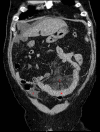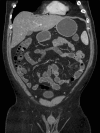Acute Abdominal Pain as the Initial Presentation of an Acquired C1 Inhibitor Deficiency
- PMID: 39114328
- PMCID: PMC11305688
- DOI: 10.1159/000533179
Acute Abdominal Pain as the Initial Presentation of an Acquired C1 Inhibitor Deficiency
Abstract
Introduction: Acquired angioedema (AAE), a rare cause of adult-onset non-urticarial mucocutaneous angioedema, can present as acute abdomen, a frequent complaint in the emergency room (ER), often leading to unnecessary and potentially harmful procedures.
Case presentation: We report a 47-year-old hypertense male, controlled with an angiotensin converting enzyme inhibitor (ACEI), who presented in the ER with progressively worsening abdominal pain, nausea, and vomiting, and a radiologic workup revealing small intestine thickening, initially diagnosed with ACEI-induced angioedema. However, further investigation revealed low serum levels of C4, C1q, and C1 inhibitors, with an abnormal function of the latter, favoring the diagnosis of AAE instead. The frequent association of this condition with lymphoproliferative disorders encouraged further studies, which unveiled a monoclonal gammopathy IgM/Kappa, representing an increased risk of Waldenström macroglobulinemia, non-Hodgkin lymphoma, and multiple myeloma.
Discussion: AAE should be regarded as an important differential diagnosis in patients presenting with acute abdomen in the ER, especially when more common causes are excluded. A correct and early diagnosis may represent a chance for a better prognosis of underlying diseases.
Introdução: O angioedema adquirido (AA), causa rara de angioedema mucocutâneo não urticariforme de início tardio, pode ter como apresentação inicial abdómen agudo, motivo frequente de admissão no serviço de urgência (SU), promovendo frequentemente procedimentos desnecessários e potencialmente prejudiciais.
Apresentação do caso: Um homem de 47 anos, hipertenso e controlado com um inibidor da enzima conversora de angiotensina (IECA), recorreu ao SU por um quadro de dor abdominal com agravamento progressivo, náuseas e vómitos. A investigação radiológica inicial revelou espessamento do intestino delgado, culminando num diagnóstico preliminar de angioedema induzido por IECA. No entanto, uma investigação mais aprofundada em regime ambulatório revelou níveis séricos reduzidos de C4, C1q e de inibidor de C1, com função anormal deste último, favorecendo o diagnóstico de AA. A associação frequente desta condição com distúrbios linfoproliferativos incentivou investigação adicional, que revelou uma gamopatia monoclonal IgM/Kappa, representando um risco aumentado de macroglobulinemia de Waldenström, linfoma não-Hodgkin e mieloma múltiplo.
Discussão: O AA deve ser considerado um diagnóstico diferencial de abdómen agudo, principalmente após exclusão de causas mais frequentes. Um diagnóstico precoce pode contribuir para um melhor prognóstico da patologia subjacente.
Keywords: Abdominal pain; Angioedema; C1 esterase inhibitor; Lymphoproliferative disorders; Monoclonal gammopathy.
© 2023 The Author(s).Published by S. Karger AG, Basel.
Conflict of interest statement
The authors have no conflicts of interest to declare.
Figures


Similar articles
-
[Acquired C1 esterase inhibitor deficiency via bradykinin-mediated angioedema: Four cases].Ann Dermatol Venereol. 2018 Oct;145(10):598-602. doi: 10.1016/j.annder.2018.02.012. Epub 2018 Apr 17. Ann Dermatol Venereol. 2018. PMID: 29673745 French.
-
Acquired Angioedema due to C1-Inhibitor Deficiency: A Challenging Condition.Int Arch Allergy Immunol. 2022;183(5):572-577. doi: 10.1159/000521646. Epub 2022 Mar 24. Int Arch Allergy Immunol. 2022. PMID: 35325890
-
Small bowel angioedema due to acquired C1 inhibitor deficiency: a case report and overview.Eur J Gastroenterol Hepatol. 2013 Apr;25(4):507-13. doi: 10.1097/MEG.0b013e32835c94ff. Eur J Gastroenterol Hepatol. 2013. PMID: 23255023 Review.
-
Angioedema as the first presentation of B-cell non-Hodgkin lymphoma--an unusual case with normal C1 esterase inhibitor level: a case report.BMC Res Notes. 2014 Aug 7;7:495. doi: 10.1186/1756-0500-7-495. BMC Res Notes. 2014. PMID: 25099363 Free PMC article.
-
Acquired C1-inhibitor deficiency and lymphoproliferative disorders: a tight relationship.Crit Rev Oncol Hematol. 2013 Sep;87(3):323-32. doi: 10.1016/j.critrevonc.2013.02.004. Epub 2013 Mar 13. Crit Rev Oncol Hematol. 2013. PMID: 23490322 Review.
References
-
- Shi Y, Wang C. Where we are with acquired angioedema due to C1 inhibitor deficiency: a systematic literature review. Clin Immunol. 2021;230:108819. - PubMed
-
- Kesh S, Bernstein JA. Isolated angioedema: a review of classification and update on management. Ann Allergy Asthma Immunol. 2022;129(6):692–702. - PubMed
-
- Otani IM, Banerji A. Acquired C1 inhibitor deficiency. Immunol Allergy Clin North Am. 2017;37(3):497–511. - PubMed
-
- Zanichelli A, Azin GM, Wu MA, Suffritti C, Maggioni L, Caccia S, et al. . Diagnosis, course, and management of angioedema in patients with acquired C1-inhibitor deficiency. J Allergy Clin Immunol Pract. 2017;5(5):1307–13. - PubMed
-
- Pines JM, Poarch K, Hughes S. Recognition and differential diagnosis of hereditary angioedema in the emergency department. J Emerg Med. 2021;60(1):35–43. - PubMed
LinkOut - more resources
Full Text Sources
Miscellaneous

